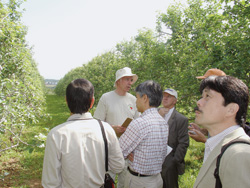
Features
Production
Research
Nova Scotia and Japan may initiate apple tree research partnership
may initiate apple tree research partnership
April 1, 2008 By Dan Wooley
In November, a four-member
delegation including Dr. Philip Hicks, Nova Scotia Agricultural College
president, Dr. Vasantha Rupasinghe, NSAC’s tree fruit bio-products
research chair, Dr. David Percival, NSAC fruit scientist and Charles
Embree, an apple researcher with the federal government’s Atlantic Food
and Horticultural Research Centre in Kentville, flew across the Pacific
to visit the National Institute of Fruit Tree Science in Morioka, Japan.
 |
| Researchers from Japan tour an orchard during a recent visit to Nova Scotia. They also visited fruit research plots in Ontario. Submitted Photo |
In November, a four-member delegation including Dr. Philip Hicks, Nova Scotia Agricultural College president, Dr. Vasantha Rupasinghe, NSAC’s tree fruit bio-products research chair, Dr. David Percival, NSAC fruit scientist and Charles Embree, an apple researcher with the federal government’s Atlantic Food and Horticultural Research Centre in Kentville, flew across the Pacific to visit the National Institute of Fruit Tree Science in Morioka, Japan.
Their tour of NIFTS follows a visit this past August of six of its research scientists to Nova Scotia and Ontario. Dr. Rupasinghe sees his group’s return visit as quite possibly the start of joint research between NIFTS, NSAC and AFHRC.
Rupasinghe is assembling a team of Canadian tree fruit researchers to collaborate with them, as he is now at the point of data sharing with the Japanese.
“The first step will be to share current research findings and technology, with the next step being the initiating of joint research, including the exchange of tree fruit germ plasm such as rootstocks,” he said. “The third is establishing exchange students and visiting researchers.”
According to Rupasinghe, the NIFTS scientists were very pleased with what they saw of Canadian tree fruit research at the Kentville research centre and field research in nearby Annapolis Valley orchards. The group also visited Ontario, more specifically the University of Guelph’s tree fruit research station at Vineland, Brock University’s viticulture institute, and a commercial winery.
Rupasinghe sees great opportunities in research collaboration for both Japan and Canada. Asked about how the Japanese researchers reacted to the Annapolis Valley tree fruit industry, he felt they were interested in the Valley growers’ approach to Integrated Fruit Production and
intensive growth practices.
“They were impressed by our environmental practices, our use of Surround to control apple maggot, IFP, and our concern for the environment in fruit production.”
The NIFTS scientists were also interested in what Rupasinghe is doing in his NSAC value-added tree fruit products development laboratory.
During the researchers’ visit to the NSAC, Dr Hicks expressed his hope “for a long-term relationship on behalf of research collaboration.”
Their visit to Canada developed out of contacts Dr Hicks made when stationed in Japan as a former Canadian diplomat.
NIFTS has 150 scientists whose principal goal is the creation of high-quality, cost-effective apple production systems. Japan has 46,000 hectares of apple orchards with 50 per cent of the crop dedicated to Fuji production, one of 12 cultivars developed by NIFTS.
The Japanese research centre has also developed a new rootstock series that is resistant to crown rot and is easy to propagate, plus a rootstock that supports a tree just three metres high so it can be harvested largely without ladders.
NIFTS is now researching new planting systems using several different apple varieties, including Macintosh, and a Y-trellis suspension to determine if it will be a less labour-intensive management system.
The Japanese fruit tree institute is also examining bee management and pollenizers with Fuji.
Dr Hideo Bessho, NIFTS’s head of plant physiology, said in light of global warming, colour development in apples is becoming more of an issue in certain varieties and believes that by 2060, some varieties may not be suitable for production because of colour development problems in warmer climates.
His institute is now working on improving fruit colour development and also examining a new portable meter to non-destructively test for the Brix value in fruit.
Print this page